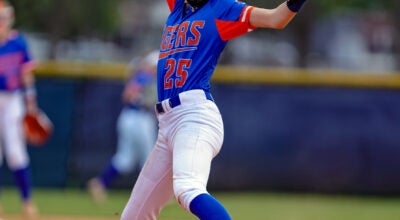Thompson fishes for, feasts on bream
Published 2:13 pm Monday, July 13, 2009
The wriggling cricket didn’t have a chance when Jackie Thompson flipped the bait near shoreline vegetation on Lake Eufaula. The small cork bobbled ever so slightly and disappeared in a flash. Thompson set the hook with his Bream Buster pole and hauled in another fine male bluegill, bull bream as we call ‘em in Alabama.
When Thompson heads to the lake in search of bream, he may end up with just one species of the popular sunfish or he may end up with the three most common that inhabit the Chattahoochee River impoundment.
“We’ve got three different species – regular old bluegill, shellcracker (redear) and warmouth,” said the 78-year-old Thompson who has fished the 45,181-acre lake since it was impounded in 1962. “You’re subject to catch those rascals all in the same place.
“More than likely when you catch them on the bed you’ll only catch one species.
Bluegill and shellcrackers may be bedding close together, but not too close. But if they’re not on the beds and you’re just casting along the bank, you might catch any of the three. And you’re just as likely to catch a channel catfish.”
The latter was true on a recent trip with Thompson, who set the hook and the Bream Buster bent double as the fish ripped one way and the other before the three-pound cat finally was led to the net.
Although Thompson admits it’s not an exact science, normally the bluegills and shellcrackers will go on the bed around eight days before the full moon and stay there until eight days after the full moon.
“That’s generally the rule, but not always,” he said. “That’s when you can catch the most in one spot. I’ve fished the lake so long that I know where most of the bedding areas are, but if I’m looking for beds I like to pitch crickets or I might throw a little jig. I’ll keep pitching until I find them.
“Sometimes when it’s like it is now – hot and humid, you can smell them real good. If it’s a big bed, when you get close, you can smell them, and I think it’s easier to smell a shellcracker bed than a bluegill.”
While bluegill and shellcracker beds can be found in the same areas, more often the shellcrackers end up in more open-water areas, according to Thompson.
“Shellcrackers will bed out in the main lake out in the flats, but I find more in the big creeks like Cowikee,” he said. “Those shellcrackers, lately, if you can find a flat 4-6 feet deep with patches of hydrilla, that’s the place to look.
“I get on the trolling motor and a good pair of polarized sunshades and look for a dark spot, which is usually hydrilla. Then I start looking nearby for a sandy spot where they’ve got it fanned out for a bed.”
The bluegills tend to congregate in the smaller bodies of water like creeks and pockets off the main creek channels.
“And if those places have grass, it’s a lot better,” Thompson added.
Thompson usually catches warmouth, aka goggle-eye and stumpknocker, around some sort of wood structure. The fish’s large mouth means it will eat a variety of baits.
“I’ve even caught them on plastic worms,” he said. “And a big warmouth would be a half a pound, so that tells you how big his mouth is.”
Thompson’s bream tackle includes a 12-foot Bream Buster pole with 8-pound test line, a small cork and No. 8, long-shank panfish hook. He also carries an ultralight spinning outfit with 6- or 8-pound test line and a slip cork.
“If the water is clear and I don’t want to spook them then I flip the cricket with the spinning tackle,” he said. “It’s kinda like pitching for bass. I can flip that cricket into spot I can’t reach with the pole. When I’m fishing holes in the grass I use the Bream Buster.”
When the fish are not on the bed, Thompson will sometimes take an eighth-ounce Beetle Spin and parallel the grass. He prefers the catalpa worm color or black with chartreuse stripes.
“On days that they are feeding and aggressive you can take that Beetle Spin and catch a bunch,” he said. “And it sure is a whole lot of fun. Now when they’re on the bed, you don’t catch many on the Beetle Spin. They’re not going to leave the bed to chase a bait.”
.
When Thompson guides for bream, he makes sure he’s got plenty of crickets if the bluegills are biting. He’ll take 150-200 crickets for one outing. If the shellcrackers are cooperating, he’ll carry plenty of worms.
“Now you’ll catch some shellcrackers on crickets, but I catch more on worms,” he said. “I’ve found they like swamp wigglers the best. It’s a big, black worm and it has a fit when you dig him up. Some get as big as a pencil. I’ll use pink worms or nightcrawlers if I can’t get swamp wigglers
“I take a single worm, hook him right in the middle and pitch him out there on the bottom. Sometimes, I’ve rigged them up like I would a Carolina rig for bass with 12-14 inches of leader. A lot of times you need to be real still, so I’ll just put the rod in the holder and leave a little slack in the line. A lot of times shellcrackers bite real easy. When the line starts move, you set the hook.”
Thompson said the shellcrackers and some bluegills will usually bed the first full moon of April.
“Depending on the weather, it could be a light spawn,” he said. “If it’s been a warm spring, it’ll be a good spawn. The best spawns are in May, June, July and August and it tapers off in September. I’ll start pitching the banks after September because they’ll be scattered.”
Thompson said a special time on Eufaula is when a willowfly (mayfly) hatch causes a feeding frenzy.
“You can ease up the creeks and river on the north end and look for willowflies,” he said. “If you find some, you can bump a limb and let them fall in the water.
The dead giveaway is when you hear that sucking sound when they’re feeding on top. Then you put on a cricket and flip it up under the willows.
“And you never know what you’re going to catch. It could be catfish, bream, bass or crappie. Everything gets after the willowflies. It’s an easy meal. That’s what’s it’s all about for the fish.”
Thompson said limits of bream (50 per person) are easy to come by if conditions are halfway decent. The bluegills will usually range from a quarter to half a pound with an occasional three-quarter-pounder, while he has seen numerous one-pound shellcrackers.
That means there will be plenty of scaling to do in preparation for a big fish fry.
“A bluegill, to me, is a better-eating fish,” Thompson said. “It’s sweeter. Shellcrackers are a little drier, but I’m not turning them down.”
Thompson goes to a little extra trouble during the cleaning process. After the fish his scaled and head and guts removed, he takes the filet knife and runs it beside the dorsal and anal fins and then pulls the fins out with pliers.
“That way he’s got a tail and no other fins,” he said. “It’s a lot easier to eat. I like those rascals deep fried. I soak them in buttermilk. Sprinkle a little salt and roll in meal and flour or Zatarain’s Fish Fry Mix. That’s the way I like them. I’ve never cooked them any other way. They’re too good fried.”
Thompson, who also guides for bass, offers bream fishing trips for $100 for a half-day and $200 for a full day. Contact Thompson at 334-687-9595 or 334-695-2192.
“The cool thing is you can bring your boat, go with me for half day and then you can do your own thing,” he said. “Once I show you around a little, the fish usually cooperate.”






